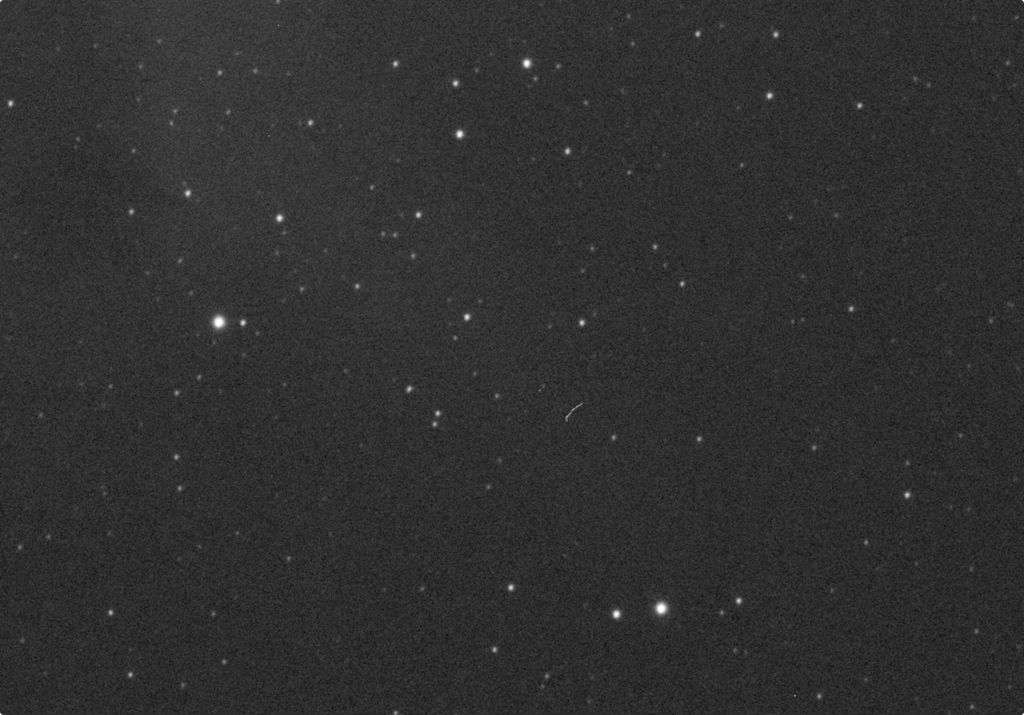But what is it? I get something like this, sometimes more squiggled almost every night. Not in the same place either.  |
You cannot like this item. Reason: "ANONYMOUS".
You cannot remove your like from this item.
Editing a post is only allowed within 24 hours after creating it.
You cannot Like this post because the topic is closed.
Copy the URL below to share a direct link to this post.
This post cannot be edited using the classic forums editor.
To edit this post, please enable the "New forums experience" in your settings.
Those are cosmic rays hitting your sensor.
|
You cannot like this item. Reason: "ANONYMOUS".
You cannot remove your like from this item.
Editing a post is only allowed within 24 hours after creating it.
You cannot Like this post because the topic is closed.
Copy the URL below to share a direct link to this post.
This post cannot be edited using the classic forums editor.
To edit this post, please enable the "New forums experience" in your settings.
I had one that made a loop like a cursive lowercase L before. Cosmic rays can do that?
|
You cannot like this item. Reason: "ANONYMOUS".
You cannot remove your like from this item.
Editing a post is only allowed within 24 hours after creating it.
You cannot Like this post because the topic is closed.
Copy the URL below to share a direct link to this post.
This post cannot be edited using the classic forums editor.
To edit this post, please enable the "New forums experience" in your settings.
There are different particles with different mass and energy connected to what we refer to as "cosmic rays". Those have different atenuation properties and thus different stopping ranges in the sensor.
So, depending on what particle hits your sensor you might see different effects.
A high energetic muon will probably just pass through in a straight line and trigger a single pixel, while electrons can bounce off multiple times and create curly paths.
|
You cannot like this item. Reason: "ANONYMOUS".
You cannot remove your like from this item.
Editing a post is only allowed within 24 hours after creating it.
You cannot Like this post because the topic is closed.
Copy the URL below to share a direct link to this post.
This post cannot be edited using the classic forums editor.
To edit this post, please enable the "New forums experience" in your settings.
Well that’s interesting. Maybe I’ll save some of the more interesting ones and create a collage.
|
You cannot like this item. Reason: "ANONYMOUS".
You cannot remove your like from this item.
Editing a post is only allowed within 24 hours after creating it.
You cannot Like this post because the topic is closed.
Copy the URL below to share a direct link to this post.
This post cannot be edited using the classic forums editor.
To edit this post, please enable the "New forums experience" in your settings.
I don't remember the reference but straight lines are supposedly cosmic ray strikes and curves lines are from ground-based radiation. Ground based radiation streaks was stated to be more commonly experienced when the imaging setup is on concrete.
|
You cannot like this item. Reason: "ANONYMOUS".
You cannot remove your like from this item.
Editing a post is only allowed within 24 hours after creating it.
You cannot Like this post because the topic is closed.
Copy the URL below to share a direct link to this post.
This post cannot be edited using the classic forums editor.
To edit this post, please enable the "New forums experience" in your settings.
I was testing dark current of my RisingCam IMX571 camera a couple years back and left the camera running for a total of 27 hours with an hour per exposure also to see if there are "hits" on the sensor.  The image is downsized a little bit and saved as a lower quality JPEG to fit the 5mb limit here, but loads of streaks can still be seen in the image. The image was stacked using maximum value combination so that they are easier to see, and was also just stretched to make them visible (less than 2 electrons per hour at -10c). In the raw data i measure these streaks ranging from a few dozen to a couple hundred electrons. And i also occasionally see these in my subs, as well as the reject high image that Siril saves if the option was ticked. Camera was in my 6th floor apartment at the time, so plenty of concrete all around. As far as i know there is no way to tell if some of these are cosmic rays, but it is possible. Most likely they are from local sources of background radiation, but still an interesting test.
|
You cannot like this item. Reason: "ANONYMOUS".
You cannot remove your like from this item.
Editing a post is only allowed within 24 hours after creating it.
You cannot Like this post because the topic is closed.
Copy the URL below to share a direct link to this post.
This post cannot be edited using the classic forums editor.
To edit this post, please enable the "New forums experience" in your settings.
If you have too much time at your hand and some dry ice https://www.youtube.com/watch?v=BeohJbfgp_M |
You cannot like this item. Reason: "ANONYMOUS".
You cannot remove your like from this item.
Editing a post is only allowed within 24 hours after creating it.
You cannot Like this post because the topic is closed.
Copy the URL below to share a direct link to this post.
This post cannot be edited using the classic forums editor.
To edit this post, please enable the "New forums experience" in your settings.
D. Jung:
There are different particles with different mass and energy connected to what we refer to as "cosmic rays". Those have different atenuation properties and thus different stopping ranges in the sensor.
So, depending on what particle hits your sensor you might see different effects.
A high energetic muon will probably just pass through in a straight line and trigger a single pixel, while electrons can bounce off multiple times and create curly paths. are there strong enough magnetic fields inside a camera to cause an electron to curve it's path tightly enough to hit multiple pixels?
|
You cannot like this item. Reason: "ANONYMOUS".
You cannot remove your like from this item.
Editing a post is only allowed within 24 hours after creating it.
You cannot Like this post because the topic is closed.
Copy the URL below to share a direct link to this post.
This post cannot be edited using the classic forums editor.
To edit this post, please enable the "New forums experience" in your settings.
TiffsAndAstro:
D. Jung:
There are different particles with different mass and energy connected to what we refer to as "cosmic rays". Those have different atenuation properties and thus different stopping ranges in the sensor.
So, depending on what particle hits your sensor you might see different effects.
A high energetic muon will probably just pass through in a straight line and trigger a single pixel, while electrons can bounce off multiple times and create curly paths.
are there strong enough magnetic fields inside a camera to cause an electron to curve it's path tightly enough to hit multiple pixels? The main effect here is probably scattering. Exact path are difficultl to predict, and usually you would use Monte Carlo simulations to do that. I didn't read the full paper but you can see an example here https://www.researchgate.net/publication/26306197_Experimental_observation_of_the_improvement_in_MTF_from_backthinning_a_CMOS_direct_electron_detectorYou would need magnetic fields of several 100mT to ~1T, even for low energy electrons to create this type of deflection over such short distance. If you feel like it you can use Lorentz equation to calculate it (if you do that for the relativistic case, it becomes a nice coupled differential equation to solve on a rainy Sunday).
|
You cannot like this item. Reason: "ANONYMOUS".
You cannot remove your like from this item.
Editing a post is only allowed within 24 hours after creating it.
You cannot Like this post because the topic is closed.
Copy the URL below to share a direct link to this post.
This post cannot be edited using the classic forums editor.
To edit this post, please enable the "New forums experience" in your settings.




